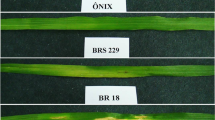Abstract
Inoculation of cotyledons with Alternaria macrospora or application of 2,6-dichloroisonicotinic acid to cotyledons caused the next emerging leaves to become less susceptible to infection by A. macrospora than those on control plants. This effect was demonstrated in cotton cultivars Siokra and Deltapine using young plants raised and tested under glasshouse conditions. The treatments applied to the cotyledons had no visible effect on the development of the plants and 2,6-dichloroisonicotinic acid had no direct effect on the fungus in vitro, suggesting that resistance was induced systemically in cotton plants.
Similar content being viewed by others
References
Ahl Goy, P., Metraux, J. P., Speich, J. and Staub, T. (1990) — Derivatives of isonicotinic acid induce resistance to viruses, bacteria and fungi in tobacco. Proceedings of the 5th International Symposium on the Molecular Genetics of Plant-Microbe Interactions, Interlaken, Switzerland, p. 366.
Bashi, E., Rotem, J., Pinnschmidt, H, and Kranz, J. (1983) — Influence of controlled environment and age on development of Alternaria macrospora and on shedding of leaves in cotton. Phytopathology 73: 1145–1147.
Cloud, A. M. E. and Deverall, B. J. (1987) — Induction and expression of systemic resistance to the anthracnose disease in bean. Plant Pathology 36: 551–557
Gaffney, T., Freidrich, L., Vernoij, B., Negrotto, D., Nye, G., Uknes, S., Ward, E., Kessmann, H. and Ryals, J. (1993) — Requirement of salicylic acid for the induction of systemic acquired resistance. Science 261: 754–756.
Jones, G. H. (1928) — An Altemaria disease of the cotton plant. Annals ofBotany 42: 935–947.
Karban, R. and Carey, J. R. (1984) — Induced resistance of cotton seedlings to mites. Science 225: 53–54.
Karban, R., Adamchak, R. and Schnathorst, C. (1987) — Induced resistance and interspecific competition between spider mites and a vascular wilt fungus. Science 235: 678–680.
Kuć, J. (1983) — Induced systemic resistance in plants to diseases caused by fungi and bacteria. In The Dynamics of Host Defence (Eds J. A. Bailey and B. J. Deverall), pp. 191–221. Academic Press, Sydney.
Linthorst, H. J. M. (1991) — Pathogenesis-related proteins of plants. Critical Reviews in Plant Sciences 10: 123–150.
Mace, M. E., Stipanovic, R. D. and Bell, A. A. (1985) — Toxicity and role of terpenoid phytoalexins in verticillium wilt resistance in cotton. Physiological Plant Pathologv 26: 209–218.
Malamy, J., Carr, J. P., Klesig, D. F. and Raskin, I. (1990) — Salicylic acid: a likely endogenous signal in the resistance response of tobacco to viral infection. Science 250: 1002–1004.
Mead, R. and Cumow, R. N. (1983) — Statistical Methods in Agricultural and Experimental Biology. Chapman and Hal1, New York.
Métraux, J. P., Ahl Goy, P., Staub, T., Speich, J., Steinman, A., Ryals, J. and Ward, E. (1991) — Induced systemic resistance in cucumbers in response to 2,6-dichloro-isonicotinic acid and pathogens. In Advances in Molecular Genetics of Plant-Microbe Interactions. Volume 1 (Eds H. Hennecke and D. P. S. Verma), pp. 432–439. Kluwer Acad. Publ., Netherlands.
Rotem, J., Blickle, W. and Kranz, J. (1988) — Effect of environment and host on sporulation of Alternaria macrospora in cotton. Phytopathology 79: 263–266.
Sequeira, L. (1983) — Mechanisms of induced resistance in plants. Annual Review of MicroBiology 37: 51–79.
Smith, J. A. and Metraux, J.-P. (1991) — Pseudomonas syringae pv, syringae induces systemic resistance to Pynculana orytae in rice. Physiological and Molecular Plant Pathology 39: 451–461.
Ward, E. R., Uknes, S. J., Williams, S. C., Dincher, S. S., Wiederhold, D. L., Alexander, D. C., Ahl-Goy, P., Métraux, J.-P. and Ryals, J. A. (1991) — Coordinate gene activity in response to agents that induce systemic acquired resistance. The Plant Cell 3: 1085–1094.
Yalpani, N., Silverman, P., Wilson, T. M. A., Kleier, D. A. and Raskin, I. (1991) — Salicylic acid is a systemic signal and an inducer of pathogenesis-related proteins in virus-infected tobacco. The Plant Cell 3: 809–818.
Author information
Authors and Affiliations
Rights and permissions
About this article
Cite this article
Brock, P.M., Inwood, J.R.B. & Deverall, B.J. Systemic induced resistance to Alternia macrospora in cotton (Gossypium hirsutum). Australasian Plant Pathology 23, 81–85 (1994). https://doi.org/10.1071/APP9940081
Received:
Accepted:
Issue Date:
DOI: https://doi.org/10.1071/APP9940081



